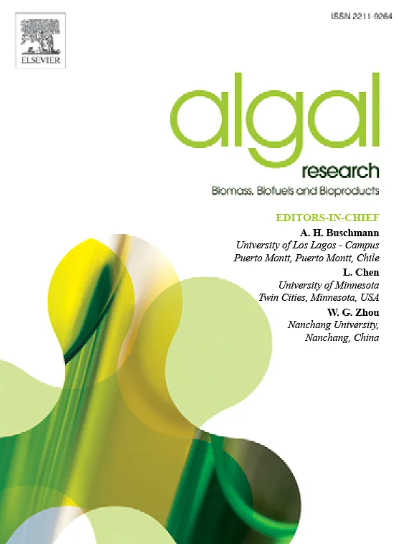Collection of rich microalgae from textile wastewater and utilized for hydrogen production via hydrothermal gasification route: Performance study
IF 4.6
2区 生物学
Q1 BIOTECHNOLOGY & APPLIED MICROBIOLOGY
Algal Research-Biomass Biofuels and Bioproducts
Pub Date : 2025-04-17
DOI:10.1016/j.algal.2025.104052
引用次数: 0
Abstract
In this investigation, textile wastewater was treated in an open raceway pond to promote algae growth for biomass production. Various environmental factors initially hindered the growth of algae. However, the growth rate was improved by integrating titanium dioxide (TiO2) nanoparticles at different concentrations. The concentrations tested included 0, 2, 4, and 6 % by weight in the wastewater. The study analyzed specific growth rates and biomass production resulting from these variations. Additionally, the cultivated algae were utilized in hydrothermal gasification for hydrogen production. This gasification process was conducted under a residence time of 30 min and a pressure of 200 bar, with gasification temperatures of 350, 450, 550, and 650 °C. Gasification efficiency was further enhanced using a potassium hydroxide (KOH) catalyst. At a higher TiO2 nanoparticle concentration of 6 %, the specific growth rate and biomass production achieved were approximately 67.9 % and 75.3 %, respectively. In the hydrothermal gasification process, the gasification efficiency (GE), hydrogen selectivity, and higher heating value (HHV) were measured at about 81.5 %, 94.6 %, and 31.5 MJ/Nm3 at 650 °C with the 5 % of KOH catalyst, showing a significant improvement compared to conditions without a catalyst.
从纺织废水中收集富微藻并经水热气化路线用于制氢:性能研究
本研究在一个开放的回旋池中处理纺织废水,以促进藻类的生长,用于生物质生产。各种环境因素最初阻碍了藻类的生长。然而,不同浓度的二氧化钛(TiO2)纳米颗粒的整合提高了生长速度。测试的浓度包括废水中重量的0、2、4和6%。该研究分析了这些变化导致的特定生长率和生物量产量。此外,还将培养的藻类用于水热气化制氢。气化过程在停留时间为30分钟,压力为200 bar,气化温度为350、450、550和650℃的条件下进行。使用氢氧化钾(KOH)催化剂进一步提高了气化效率。当TiO2纳米颗粒浓度为6%时,特定生长率和生物量产量分别约为67.9%和75.3%。在水热气化过程中,在650℃条件下,当KOH用量为5%时,气化效率(GE)、氢气选择性(氢气选择性)和高热值(HHV)分别为81.5%、94.6%和31.5 MJ/Nm3,与无催化剂条件相比有显著提高。
本文章由计算机程序翻译,如有差异,请以英文原文为准。
求助全文
约1分钟内获得全文
求助全文
来源期刊

Algal Research-Biomass Biofuels and Bioproducts
BIOTECHNOLOGY & APPLIED MICROBIOLOGY-
CiteScore
9.40
自引率
7.80%
发文量
332
期刊介绍:
Algal Research is an international phycology journal covering all areas of emerging technologies in algae biology, biomass production, cultivation, harvesting, extraction, bioproducts, biorefinery, engineering, and econometrics. Algae is defined to include cyanobacteria, microalgae, and protists and symbionts of interest in biotechnology. The journal publishes original research and reviews for the following scope: algal biology, including but not exclusive to: phylogeny, biodiversity, molecular traits, metabolic regulation, and genetic engineering, algal cultivation, e.g. phototrophic systems, heterotrophic systems, and mixotrophic systems, algal harvesting and extraction systems, biotechnology to convert algal biomass and components into biofuels and bioproducts, e.g., nutraceuticals, pharmaceuticals, animal feed, plastics, etc. algal products and their economic assessment
 求助内容:
求助内容: 应助结果提醒方式:
应助结果提醒方式:


